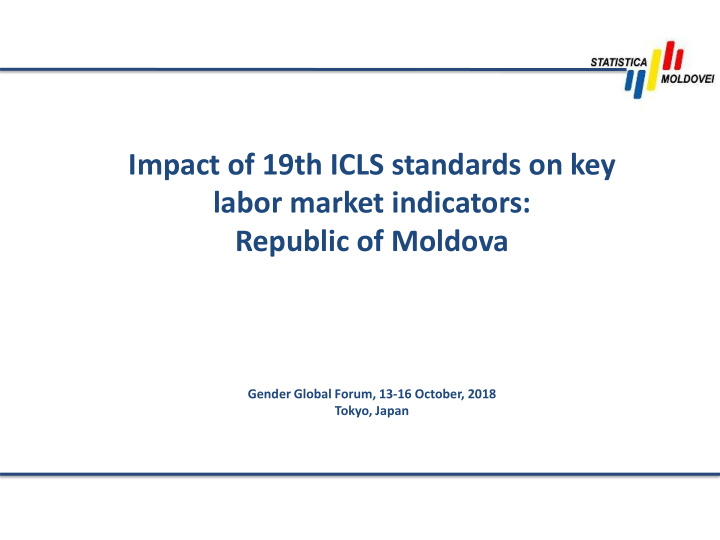



Impact of 19th ICLS standards on key labor market indicators: Republic of Moldova Gender Global Forum, 13-16 October, 2018 Tokyo, Japan
Outlines: ✓ Labour Statistics background ✓ Implementation of new standards ✓ Impact of new standards on key indicators ✓ Challenges faced to communicate new indicators
Country background ✓ Population 2.9 million ✓ GDP/capita: 2.7 thous. USD ✓ Average salary: 308 USD ✓ Remittances as % of GDP: 20% ✓ Employment rate: Men 42%, women 38% ✓ Gender pay gap: 14% ✓ Absolute poverty rate: 25%
Labour Statistics background ✓ Stand - alone survey, since 1998 ✓ Quarterly estimates ✓ Follows international recommendations. Additional data sources: - ad-hoc modules: transition from work to retirement (2017), volunteering activity (2015), labour migration (2012), school to work transition (2013, 2015), reconciliation of work and family life (2010). - Time Use survey (2012) - Child labour (2009)
Labour Statistics background Employment: ✓ any economic activity that 30 900 generates monetary and/or 800 25 700 in kind income 20 600 ✓ including own production 500 15 of agricultural foodstuff 400 used for own consumption, 10 300 if working more than 20 200 5 hours. 100 0 0 2000 2005 2010 2011 2012 2013 2014 2015 2016 2017 Strict definition of % agriculture in GDP employment in agriculture, th.persons unemployment, all criteria (not employed, seeking, available)
Labour Statistics background 45 40.5 40 35 32.3 30 25 20 200 50 180 45 15 160 40 10 140 35 5 4.1 120 30 0 100 25 2010 2011 2012 2013 2014 2015 2016 2017 80 20 employment rate, % 60 15 % of agriculture in total employment 40 10 unemployment rate, % 20 5 0 0 2010 2011 2012 2013 2014 2015 2016 2017 What is the share of agricultural production employment in agriculture only for own consumption, th. Persons % of agriculture production for own consumption used only for own consumption?
Implementation of new standards ✓ First statistical definition of ‘work’ ✓ Definitions for 5 different forms of work ▪ Employment (narrower than previous Key elements of 19 th definition) ▪ Own use production work (goods or ICLS Resolution services) ▪ Volunteer work (goods or services) ▪ Unpaid trainee work ▪ Other ✓ Four different indicators defined (LU1 to LU4)
Implementation of new standards Exclusion of own use Labour agricultural production underutilisation indicators based on available data up to 2017 no need for questionnaire changes questions refinement on own production of agriculture mainly for sale and own consumption data available since 2017 data will be available in 2019
Implementation of new standards Employment rate, % 42 7.0 6.0 40 5.0 38 4.0 36 3.0 Employment in agriculture (th.persons) 34 2.0 500 32 1.0 400 30 0.0 300 2010 2011 2012 2013 2014 2015 2016 2017 200 old new difference, p.p 100 0 2016 2017 2016 2017 old new total women men
Impact on key indicators Employment rate by sex Gender gap in employment rate 50 6 45 5.0 40 5 35 4.0 3.9 30 4 3.4 25 3.2 20 3 2.4 15 10 2 5 0 1 2015 2016 2017 2015 2016 2017 old definition new definition 0 old definition new definition 2015 2016 2017 men women ✓ Employment rate is decreasing ✓ The gender gap in employment rate is decreasing
New indicators Labour underutilisation, % 13.3 14 12.3 12 10 8.7 7.8 8 5.9 Labour underutilisation 6 4.8 4.2 not employed 3.3 4 seeking for a job, not 2 available 0 available, but not LU1 unemployment LU2 unemployment+time LU3 LU4 composite measure of seeking for a job related underemployment unemployment+potential underemployment labour force time women men underemployment
Implementation of new standards Awareness on new international standards 2016: ✓ Capacity building of NSO staff ✓ National workshop on presenting the requirement of 19 th ICLS resolution and possible impact on key indicators 2017: ✓ National workshop for key ministries responsible for labour market policy/in-house training of technical staff ✓ Approval of new methodology ✓ Release of LU1-LU4 indicators based on old definition on employment !!! Nevertheless, it was decided to release new indicators on employment starting with 2019
Relevance of new indicators Policy instruments Statistical planning • National Employment Strategy 2017- • National Development Strategy of 2021 Statistics 2016-2020 • National Strategy on Ensuring • Annual statistical program Equality between • Statistical products women and men 2017-2021 • National Development Strategy “Moldova 2030” NDS Moldova 2030, Employment Rate Initial reference 2017 Target 2022 Target 2026 Final target 2030 Old – 40,5% 45% 50% 60% New – 34,4% National Employment strategy 2017-2021, Employment Rate Initial reference 2016 old new Final target 2021 Total 40,8% 34,8% 44,1% Women 39,0% 33,0% 42,6% Men 43,0% 36,5% 45,6%
Challenges ✓ New standards have an impact on labour market indicators especially for developing countries ✓ Limited capacities to increase awareness of 19 th ICLS standards from policy makers side ✓ Limited implication of policy makers in data exploration, engagement mechanism is crucial ✓ NSO should focus on ways to communicate the changes and new trends of data ✓ Develop partnership with academia and analytical think-tank to promote new indicators and possible implication on policy framework
Strategies to communicate new indicators ✓ Publication of key indicators using new and old standards ✓ Times series data is needed, for at least 2-3 consecutive years ✓ Publication of additional information related to agricultural activity ✓ Keep informed all interested users: -high level stakeholders (ministries, syndicates) -technical level (researchers, private sector, mass-media), -general public Next steps ✓ Release of participation rates aligned with 19th ICLS standards in 2019. ✓ Revision of target indicators from labour related policies ✓ Testing volunteer work, own use production of goods and evaluation of the potential impact on indicators ✓ Expert review of LFS data collection methodology, followed by filed test and microdata analysis
MOLDOVA 2030 A country where you want to live!
Recommend
More recommend